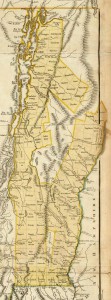 As part of the Society’s Ask a Genealogist service, I was recently asked about locating someone in post-Revolutionary War Strafford, Vermont. The time frame in which this person lived reminded me of the special considerations for this region, which was once hotly disputed by New Hampshire, New York, Vermont, and even Massachusetts.
As part of the Society’s Ask a Genealogist service, I was recently asked about locating someone in post-Revolutionary War Strafford, Vermont. The time frame in which this person lived reminded me of the special considerations for this region, which was once hotly disputed by New Hampshire, New York, Vermont, and even Massachusetts.
The territory that would become today’s Vermont was claimed by both New Hampshire and New York in the mid-eighteenth century, a squabble that took years to sort out. In general the land grants made by New Hampshire governor Benning Wentworth between 1749 and 1764 lay in territory already claimed by New York. A royal decree of 1764 awarded jurisdiction over the disputed territory to New York, which created four counties: Albany (established in 1764), and from Albany County Gloucester (1766) and Charlotte and Cumberland Counties (1772). In 1770, the New York Supreme Court declared all the Wentworth land grants invalid, at which point the residents in this area rebelled and declared themselves an independent republic. These residents created the jurisdiction of Rutland Shire (1777–1781) which become a very large Rutland County between 1781 and 1785. This republic remained a free “country” until after the American Revolution, when Vermont was admitted as the fourteenth of the United States in 1791. Some beautiful maps created by Jalanne C. Barnes outline the boundaries of these different jurisdictions and are available for 1772–1777, 1777–1781, and 1781–1785.
Strafford, in today’s Orange County, Vermont, began its existence in 1761 as one of the Wentworth land grants. As of 1764, it was briefly a part of New York’s Albany County, then a part of Cumberland County starting in 1772. Following the 1777 creation of the Vermont Republic, Orange, Windham, and Windsor Counties were established and Cumberland County abolished in 1781. Regardless of the jurisdictional dispute between New York and New Hampshire, much of the vital and land records remained with the Vermont towns recording them, while probate records are held by the probate district within the county – Strafford is covered by the Bradford Probate District, for which digital images may be viewed at https://familysearch.org/search/collection/1807377.
Overall, Vermont is a major crossroad of westward migration. Many of its settlers were from New Hampshire, but the enticement of land attracted many from Massachusetts and Connecticut as well. Their children and grandchildren in turn moved westward, following land opportunities as their parents and grandparents did.
Share this:

About Alice Kane
Alice Kane worked with NEHGS constituents until 2020, orienting and facilitating research for first-time visitors to the NEHGS headquarters. Prior to joining the staff, she was a librarian at the Boston Public Library for 19 years. Alice is an expert in Chinese and Chinese-American genealogy and also has extensive experience with French-Canadian, Irish, and German research. She earned a bachelor’s degree in History from Harvard University.View all posts by Alice Kane →